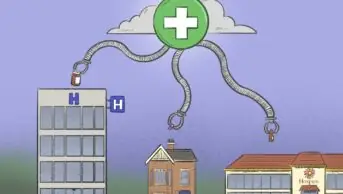
Shutterstock.com
Timely access to medicines for patients across the UK during the last 12 months of life is known to be problematic and patchy. Previous research has demonstrated that for those living at home, it can be time consuming, burdensome and require substantial coordination between healthcare professionals, patients and carers alike1–5. This comes at a time in patients’ lives when the distress and challenges that symptom control of life-limiting illnesses pose should be minimised rather than added to.
Pressures on general practice and community nursing services may be worsening this situation, contributing to rising calls to emergency services6. Data from Marie Curie’s better end-of-life care report, published in November 2024, show that of 1,179 bereaved carers across England and Wales, ambulance services had been used by more than half of those who died (n=645, 54.7%) at least once in their last three months of life7. Among these patients, the mean number of ambulance contacts was 1.9, with a range of 1–38. The frequency of calls is impacting ambulance services, increasing the need for ambulance clinicians to become involved in symptom management and medicines administration.
As part of an ongoing ParAid study — funded by Marie Curie Research Grants Scheme MC-21-802, aimed to evaluate paramedic delivery of end-of-life care — we conducted a national survey of paramedics’ current practice and experiences at end of life. The survey, results of which were published in December 2024, illustrated experiences of symptom management, medicine access and authorisation to administer medicines for individuals at end of life8. The online survey link was disseminated to paramedics working within all 11 NHS trusts employing ambulance paramedics in England, including 10 NHS ambulance trusts plus the Isle of Wight NHS Trust. In total, 920 responses were received with respondents geographically spread across England.
Medicines access
Paramedics were asked: “For this patient group, how likely are you to be required to administer medicines for symptom control?”
One-third of respondents (32%, 290) answered “always” or “often” to this question, while 46% (424) answered “sometimes”. Despite paramedics reporting administration of medicines for symptom control, access to medicines and authorisation for use were both challenging. Where 41% of respondents (381) reported “always” or “often” not having access to a specific medicine needed, 39% of respondents (356) reported “sometimes”. Where paramedics needed to administer medicines for symptom control, these medicines were predominantly supplied from patient’s own ‘just-in-case’ or anticipatory medicines supplies. However, less than half of respondents, 48% (440) reported this “always” or “often” occurred, while 28% of respondents (256) said this “sometimes” occurred. Even where patients’ own just-in-case supplies were available, authorisation was dependent on the presence of the medicines authorisation and administration record. Some 40% of respondents (364) reported this was “always” or “often” not in place, with a further 34% of respondents (313) stating that it “sometimes” was.
Only a small percentage of respondents (14%; 126) responded “yes” to the availability of an alternative supply and authorisation option in their area. This was where just-in-case medicines were supplied from core palliative care medicines, such as cyclizine, midazolam and hyoscine butylbromide, carried by specialist paramedics for use via patient group directions (PGDs).
The ability to administer just-in-case medicines by PGD does not support care when attended by ambulance technicians
The survey results demonstrate that pharmacists have a role in offering pharmaceutical support to implement guidelines from the Joint Royal Colleges Ambulance Liaison Committee (JRCALC), as well as local guidelines within ambulance trusts. This may include procuring medicines to cover end-of-life symptoms within National Institute for Health and Care Excellence guidelines, ensuring consistent end-of-life medicines provision across integrated care system boundaries, developing collaborative clinical pathways, such as topical use of tranexamic acid for patient bleed plans, educating ambulance clinicians in end-of-life medicines administration and supporting evaluation and research of effective models and interventions to administer medicines at end of life.
Currently, only four trusts in England supply just-in-case medicines for use under PGDs by trained paramedics, with pharmacists playing a crucial role in developing PGDs in addition to educating staff in medicine use. However, the ability to administer just-in-case medicines by PGD does not support care when attended by ambulance technicians, who — as non-registered staff — are unable to use PGDs.
Confidence in medicines administration
JRCALC’s end-of-life guidelines allow a trained clinician, such as a registered paramedic or ambulance technician, to administer patients’ own just-in-case medication — though specific roles and governance varies across trusts9. East Midlands Ambulance Service NHS Trust (EMAS) is the only trust in England that allows ambulance technicians to administer just-in-case medicines. Following the introduction of technician administration of just-in-case medicines in the Scottish Ambulance Service, there was an increase in the number of end-of-life medicines administered, improving patient care and providing quicker symptom relief10.
However, administering these medicines is only successful when ambulance clinicians feel confident to do so. The ParAid study survey data also demonstrated that this is problematic. When asked: “How often when attending patients in the last year of life do you not feel confident with medicines”, some 23% of respondents (213) reported “always” or “often”, and 36% of respondents (332) answered “sometimes”. Pharmacists have an important role in bolstering these confidence levels by providing essential medicines safety training to support just-in-case medicines administration. Pharmacists at EMAS have instigated a mandatory medicines training programme for all paramedics and technicians, including end-of-life case scenarios and drug calculation exercises. In addition, the provision of remote clinical advice from paramedics based at the EMAS clinical hub that supports decision-making on scene is likely to improve clinician confidence.
Future research should consider the experience of patients, carers and ambulance technicians in end-of-life care situations, focusing on patient safety and whether staff have the necessary training, education and support.
Other roles for ambulance pharmacists include supporting paramedic placements or rotations into palliative care11–13. A wider role could involve supporting undergraduate paramedic education to provide end-of-life symptom management learning that is consistent with national competency frameworks or via e-learning for health modules14,15. Pharmacists could also provide competency sign-off for just-in-case medicines administration for non-registered clinicians.
Legislative changes at a national level
Nationally, pharmacists have an important role in proposing legislative changes through the Department of Health and Social Care, with a need to ensure ambulance service pharmacists are included in such discussions to support intentions to improve care in the pre-hospital setting.
Although a statutory instrument came into force in December 2023, the impact on end-of-life care is limited
Although a statutory instrument came into force in December 2023, allowing paramedic prescribers to prescribe or direct others to administer a limited number of controlled drugs, the impact on end-of-life care is limited because only morphine is included16. Evidence suggests the administration of palliative medicines to patients in the community by a paramedic following an emergency call-out results in cost-avoidance and is safe, patient-centred and reduces transfers to hospital17,18.
Expanding the list of controlled drugs that paramedics can prescribe in the Misuse of Drugs Regulations 2001 to include diamorphine, oxycodone, fentanyl and midazolam would enable paramedic prescribers to direct other paramedics on scene in supporting patients with palliative care needs to remain at home. Amendments to the Human Medicines Regulations, schedule 17 paramedic exemption list to include just-in-case medicines, such as midazolam, hyoscine, haloperidol and levomepromazine, would support a responsive and reactive service by all paramedics. This would improve patient experience and potentially reduce conveyance to hospital, especially during the out-of-hours period when palliative care or primary care teams are not available.
Pharmacists working as part of integrated end-of-life ambulance care delivery can use their expertise to shape local and national medicines guidelines and policy, as well as provide training and advice in clinical practice to support paramedic teams to access, supply and administer medicines safely to patients in this important context.
- This article was amended on 13 June 2025 to change the opening sentence.
Conflicts of interest
The ParAid study, which is evaluating paramedic delivery of end-of-life care, is funded by the Marie Curie Research Grants Scheme MC-21-802. Natasha Campling is the chief investigator of the study; Sue Latter is a co-investigator; and Elizabeth Miller sits on the study’s advisory group. The ParAid study is in part supported by the National Institute for Health and Care Research (NIHR) Applied Research Collaboration Wessex. The views expressed in this publication are those of the authors and not necessarily those of the NIHR or the Department of Health and Social Care.
- 1.Ogi M, Campling N, Birtwistle J, et al. Community access to palliative care medicines – patient and professional experience: systematic review and narrative synthesis. BMJ Support Palliat Care. 2021;14(e2):e1565-e1574. doi:10.1136/bmjspcare-2020-002761
- 2.Latter S, Campling N, Birtwistle J, et al. Supporting patient access to medicines in community palliative care: on-line survey of health professionals’ practice, perceived effectiveness and influencing factors. BMC Palliat Care. 2020;19(1). doi:10.1186/s12904-020-00649-3
- 3.Campling N, Birtwistle J, Richardson A, et al. Access to palliative care medicines in the community: An evaluation of practice and costs using case studies of service models in England. International Journal of Nursing Studies. 2022;132:104275. doi:10.1016/j.ijnurstu.2022.104275
- 4.Campling N, Breen L, Miller E, et al. Issues affecting supply of palliative medicines into community pharmacy: A qualitative study of community pharmacist and pharmaceutical wholesaler/distributor perspectives. Exploratory Research in Clinical and Social Pharmacy. 2022;6:100132. doi:10.1016/j.rcsop.2022.100132
- 5.Latter S, Campling N, Birtwistle J, et al. Patient and carer access to medicines at end of life: the ActMed mixed-methods study. Health Soc Care Deliv Res. 2022;10(20):1-208. doi:10.3310/fiqe5189
- 6.Scobie S, Julian S, Davies M, Bagri S. What primary and community services do people who die at home receive? Nuffield Trust. 2024. https://www.nuffieldtrust.org.uk/news-item/end-of-life-care-blog
- 7.Better End of Life Report 2021 . Marie Curie. 2024. https://www.mariecurie.org.uk/policy/better-end-life-report
- 8.Campling N, Turnbull J, Richardson A, et al. Paramedics providing end-of-life care: an online survey of practice and experiences. BMC Palliat Care. 2024;23(1). doi:10.1186/s12904-024-01629-7
- 9.JRCALC Clinical Guidelines 2022. Class Professional Publishing; 2022. https://www.classprofessional.co.uk/books-ebooks/paramedic-emergency-care/2022-jrcalc-clinical-guidelines/
- 10.Mackinnon S, Fickling K, Laird C, Johnston R, Campbell S. 43 A review of end of life medication administration by ambulance clinicians. The Marie Curie Research Conference 2024. Published online January 2024:A17.2-A18. doi:10.1136/spcare-2024-mcr.40
- 11.O’Brian E, Chohan A, Sewell B, Pease N. Impact of paramedics carrying just-in-case end-of-life care medication. Journal of Paramedic Practice. 2023;15(11):447-455. doi:10.12968/jpar.2023.15.11.447
- 12.Juhrmann ML, Vandersman P, Butow PN, Clayton JM. Paramedics delivering palliative and end-of-life care in community-based settings: A systematic integrative review with thematic synthesis. Palliat Med. 2021;36(3):405-421. doi:10.1177/02692163211059342
- 13.Hough L. The new ambulance initiative helping patients at the end of life . Welsh Ambulance Services University NHS Trust. 2024. https://ambulance.nhs.wales/news/nhs/2024/the-new-ambulance-initiative-helping-patients-at-the-end-of-life/
- 14.Palliative and End-of-Life Care . South East Coast Ambulance Service NHS Foundation Trust. https://www.secamb.nhs.uk/what-we-do/about-us/palliative-and-end-of-life-care/
- 15.Smith D. Prescribing Paramedics in Palliative Care . West Midlands Palliative Care . 2024. https://www.westmidspallcare.co.uk/prescribing-paramedics-in-palliative-care/
- 16.Explanatory memorandum to the misuse of drugs (England and Wales and Scotland) (Amendment). Home Office. 2023. https://www.legislation.gov.uk/uksi/2023/1345/pdfs/uksiem_20231345_en_001.pdf
- 17.Macmillan Allied Health Professions Competence Framework . College of Paramedics. https://collegeofparamedics.co.uk/COP/Professional_development/macmillan_allied_health_professions_competence_framework/COP/ProfessionalDevelopment/macmillan_allied_health_professions_competence_framework.aspx?hkey=0841231c-19bd-413e-86c2-2381ccb57b4e
- 18.End of life and palliative care as associated with paramedic practice . NHS England . 2023. https://portal.e-lfh.org.uk/Component/Details/721434


